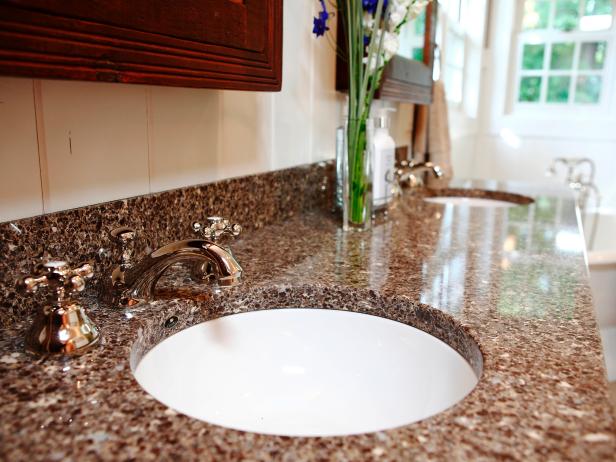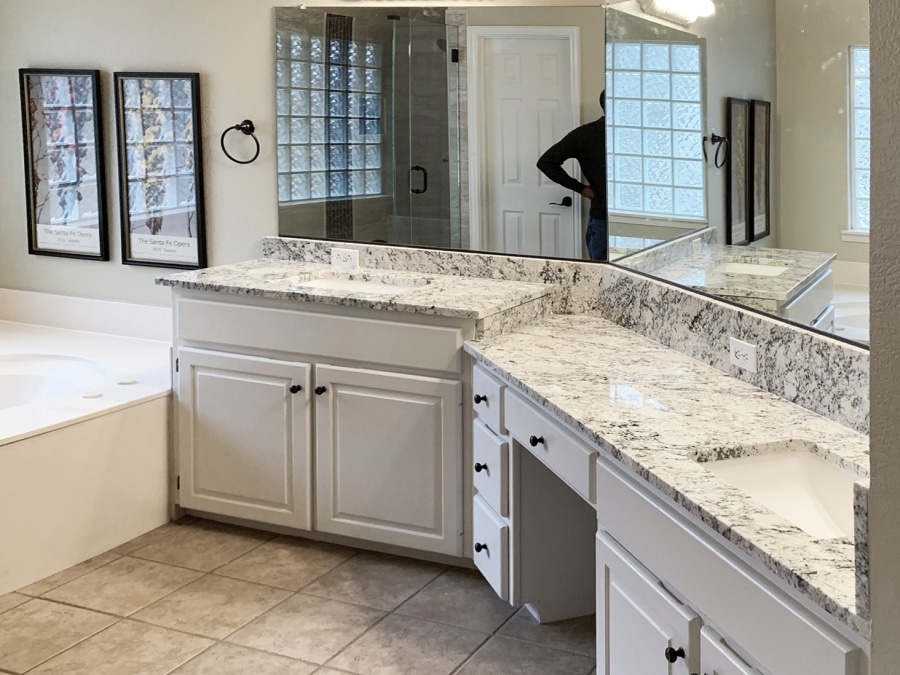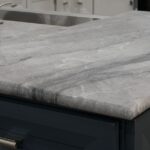Granite is one of the most popular materials for countertops for a reason. This reliable natural stone offers high resistance and easy maintenance, things every kitchen countertop requires to be considered effective. But what about vanity tops? Many come with a sign that states they have been sealed, but what does that mean? How to know if you need to seal your granite vanity top?
Sealing is an important aspect of countertop maintenance. And if you have no idea what we’re talking about, don’t worry, we’ll explain everything. We will talk about everything there is to know about sealing granite, both in kitchen countertops and vanity tops, and how you should go about it. Let’s start by explaining what sealing actually is.
People tend to think that granite is more an “utilitarian” stone, being picked more for utility than for looks. But there are lots of kinds of granite out there, and many of them are gorgeous. Do you want to know more about them? Then check out our definitive guide on granite countertops!

Sealing Granite Vanity Tops
To understand the importance of sealing, there is one fact we need to know about granite. Granite, at least in the majority of cases, is a porous material. That means spills and liquids can penetrate its structure through its pores and end up staining or etching it.
Sealing is a process in which you “fill” this pores and prevent the granite from absorbing anything. Sealing also protects the granite against scratches. But be careful! That doesn’t mean you should cut things directly on top of it. Always use cutting boards and protective coasters around granite.
Sealing your granite countertop or vanity top is an important step that cannot be overlooked. It protects your investment, and makes cleaning easier.
Sealing Granite – Water Drop Test
Two important things before giving you the guide on how to seal your granite countertop/vanity top.
First, check with a professional if the piece of granite you’re acquiring actually needs to be sealed. In some rare cases, granite does not need to be sealed. But never assume it doesn’t. Granite is porous, event if not much, and needs to be sealed. Still, it won’t harm to check with a qualified professional first.
Second, you can always perform the “Water Drop” test, and we highly recommend you do so. If you’re not sure your granite is properly sealed or think it is already time to reapply the sealer, this is a simple test you can do.
To perform the test, simply drip a small puddle of water on top of your granite. Now you must keep an eye both on the puddle and on a chronometer.
- If the puddle darkens in less than four minutes, then you need to apply multiple coast of sealer. In that case, spills should be cleared immediately, and the granite needs to be checked again after one year has passed.
- If the puddle takes between 4 and 5 minutes to darken, you still should apply some coats of sealer. You’re safe from most spills, unless they rest on top of the granite for several hours. The test should still be performed after a year.
- If it takes anything between 10 and 15 minutes for the puddle to darken, you’re safe enough. Maybe apply one small coat of sealer to make sure, but you’re safe for around 2 years.
- If after 15 minutes the puddle still hasn’t darkened, then your granite is bulletproof. In this case, sealer should not be applied, not even “just to be safe”. You can perform the tests again after 2 years, but you’ll probably be safer for 3 years or so.
Performing the Water Drop test will give you the answer if your countertop or vanity top needs to be sealed. If the answer is ‘yes’, the following step-by-step guide will help you with it.
How to Seal Granite Vanity Tops
Step 01 – Choosing the Right Sealer
Make sure to always use products specifically designed for natural stone and with a “penetrating” or “impregnating” effect. Carbon resin sealers work best, usually stating fluorocarbon aliphatic resin somewhere around the label, so keep an eye for that. When in doubt, always ask for professional help.
Once you acquired your sealer, read and follow closely the instructions on the label. Different sealers are designed with different technologies and may have some other steps during installation. Our guide covers the most common steps on how to apply sealers, but always follow the label if they have some different information than us.
Step 02 – Cleaning the Granite
Clean the granite thoroughly with a mixture of warm water and mild dish soap. After that, buff the granite as best as possible using a clean soft cloth. Wait at least 24 hours for it to completely dry before applying the sealer.
Step 03 – Apply the Sealer Evenly
Open the windows and leave the area as ventilated as possible. Also, make sure to always use working gloves.
If your sealer of choice comes in a spray bottle, you can safely apply directly on the granite. If a brush needs to be used, make sure it is completely clean of any residues.
It is recommended that you follow the next steps testing the sealer on a small area first. If the granite gets hazy or changes colors too drastically, you should find a different product.
Apply the sealer evenly, subdividing the area into small portions to have a better control over it. Don’t use too much sealer. The area should be merely damped, not completely soaked.
Step 04 – Let the Granite absorb the Sealer
Give it around 20 minutes for the sealer to do its job. 20 minutes is the standard time but, again, check the label of the product for the exact amount of time you need to wait.
Don’t fall into the trap of waiting a little longer “just to make sure”. The second coat of sealer needs to be applied when the first coat is dry enough, but not completely.
Step 05 – Second Coat
If it’s necessary, apply the second coat of sealer the same way you applied the first one. Again, you’re going to wait around 20 minutes, or as much time as the label indicated, and then you’ll want to wipe the surface of the granite with a clean cloth to remove the excess sealer.
Step 06 – Wait for 48 hours
Once everything is done, you should leave the countertop/vanity top alone for at least two days. After that, it will be ready to use.
Professional Help With Sealing Granite

Now that you know how to seal your granite countertop or vanity top, maybe you realized it is more important and complex than you originally thought to be.
You would be correct in assuming the importance of sealing, and no one would judge for deciding to hire a professional to do that job for you. That way, you’ll make sure to end up with a job well done and avoid the possibility of future frustrations.
If you happen to be around the Sarasota County, in FL, we here at Eagle Stones would be happy to help you with that and any other natural need you might have.
Give us a call anytime at +1 941-227-2000 or email us at sales@eaglestonesusa.com.



